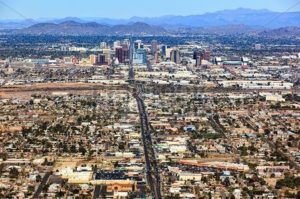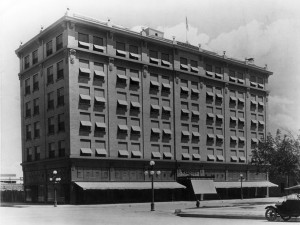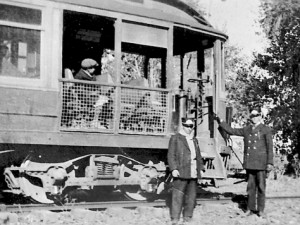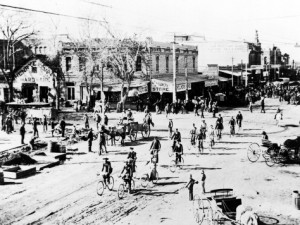The City of Phoenix defines Downtown as the area between 7th Street and 7th Avenue, from McDowell Road on the north to Buckeye Road on the south.
The history of Downtown Phoenix and Central Phoenix history runs deeper than most would expect. It’s history is rich dating back to 1867. Known as The Valley of the Sun, Downtown is now the 5th largest metropolitan city in the nation.
Location – Between the “Seven’s” or not?
Historic Downtown and Central Phoenix is generally defined “between the 7’s.” However, the majority of downtown development is concentrated in the smaller area surrounding the intersection of Washington Street and Central Avenue.
Location Perspective for Historic Phoenix Downtown
Due to major, recent growth, the location perspective on the official downtown boundaries depend on who you ask. Some define the boundaries from 7th Street on the east, the railroad tracks south of Jackson Street and Interstate 10 on the north.
However, others define it from from 16th Street on the east, to 19th Avenue on the west. Then, from Jackson Street to the south and to McDowell Road at the north. It’s all a matter of perspective as our city continues to massively grow.
Downtown Phoenix is one of a the few major business districts in the city and is the central business district of the City of Phoenix, Arizona.
Central Phoenix and Downtown Locations are Loaded with Old and New Properties
It’s located in the heart of the Phoenix metropolitan area or ‘Valley of the Sun’ with a large variety of designated historic districts housing. Many are classic, vintage homes attracting people from all walks of life. The new high-rise condos emerging are quickly changing the skyline.
Political and Governmental Buildings
Downtown Phoenix, being the county seat of Maricopa County and the capital of Arizona, serves as the center of politics, justice and government on the local, state and federal levels.
The area is a major center of employment for the region, with many financial, legal, and other national and international corporations housed in a variety of skyscrapers.
Arts, Craft’s and Sports
Major arts and cultural institutions also call the area home. Downtown Phoenix is a center of major league sports activities, live concert events. And, is an equally prominent center of banking and finance in Arizona.
Banks
Regional headquarters for several major banks, including JP Morgan Chase, Wells Fargo, US Bank, Bank of America, Compass Bank and MidFirst Bank are all located within or close proximity to the area.
A Little History of Downtown Phoenix
Early Settlement
The town of Phoenix was settled in 1867, and incorporated in 1881 as the City of Phoenix.
Territorial era
In 1870, a meeting was held to select a town site for the influx of pioneers coming to the recently recognized town of Phoenix. 320 acres were purchased for $50 raised by popular subscription.
Between the Seven’s Established Making Downtown Phoenix History
But, this original site, the whole of the town of Phoenix in that day, encompasses what would presently be the Downtown Core. It’s bordered by Van Buren Street south to Jackson Street, and 7th Street to 7th Avenue.
Washington Street
With the first survey of the new town, streets were laid out in a grid, with Washington Street as the main east-west thoroughfare.
Naming of the Streets
Originally, the north-south streets originally bore Native American tribal names. But, they were changed to more easily remembered numbers, with everything east of Center Street (later Central Avenue) named as streets and everything west as avenues. The town continued to grow, and was eventually incorporated as a city on February 28, 1881 centered around downtown.
Phoenix Incorporation
Throughout the 1880s the newly incorporated city made many strides toward modernization with the construction of one of the first electric plants in the West as well as the opening of the horse-drawn streetcar line.
The Phoenix Street Railway system was eventually electrified and expanded to several different lines that connected Downtown Phoenix to other neighborhoods and cities in the Valley.
Independence Day of 1887
Independence Day of 1887 heralded the arrival first Southern Pacific train. This opened up the economy of the young city, as goods now flowed in and out by train as opposed to wagon. As Phoenix became the center of commerce in the territory, the capital was moved to Phoenix, with temporary offices being set up in Downtown.
The Beginning of Phoenix’s Story
The city of Phoenix’s story begins as people from those settlements expanded south, in conjunction with the establishment of a military outpost to the east of current day Phoenix.
Agriculture
Phoenix served as an agricultural area that depended on large-scale irrigation projects.
Pre-World War II
Until World War II, the economy was based on the “Five C’s”: cotton, citrus and cattle, climate and copper. The city provided retail, wholesale, banking, and governmental services for central Arizona. It began gaining a national reputation among winter tourists.
Post World War II
The post-World War II years saw the city beginning to grow more rapidly. Many men who had trained in the military installations in the valley, returned, bringing their families.
Population Growth Post War
The population growth was further stimulated in the 1950s, in part because of the availability of air conditioning, which made the very hot dry summer heat tolerable. And, as an influx of industry, led by high tech companies flowed in. The population growth rate of the Phoenix metro area has been nearly 4% per year for the past 40 years.
Growth Rate Slows During the Great Depression
The growth rate slowed during the Great Recession but the U.S. Census Bureau predicted it would resume as the nation’s economy recovered, and it already has begun to do so. While currently ranked 6th in population, it is predicted that Phoenix will rank 4th by 2020. Currently it’s the 5th most populous city in the United States.
CLICK HERE to search For Downtown and Central Phoenix High Rise Luxury Condos, Lofts, Row Homes and Townhomes for sale




